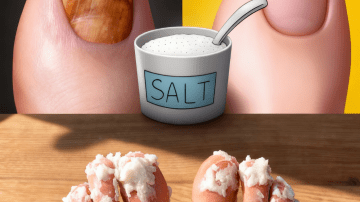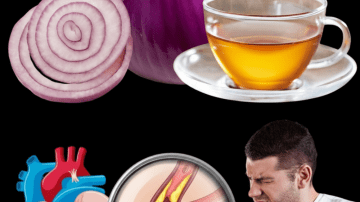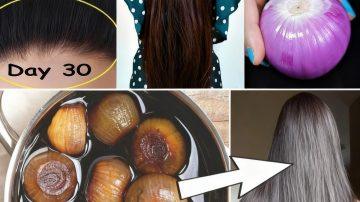How often do you brush, floss, and rinse, yet still struggle with persistent tooth sensitivity, gum irritation, or the nagging suspicion that plaque is quietly winning the war against your smile? Tooth decay (dental caries) is a relentless global epidemic, a consequence of modern diets high in sugar and a persistent buildup of harmful, acid-producing bacteria. While regular dental visits are non-negotiable, what if a simple, accessible, and highly affordable natural remedy could significantly enhance your daily defense, soothe excruciating toothaches, and actively combat the bacteria causing decay?
The answer lies in the humble, yet scientifically powerful, Guava Leaf (Psidium guajava).
Long used in traditional oral hygiene practices across Asia and South America, the guava leaf is a miniature arsenal of antimicrobial, analgesic (pain-relieving), and anti-inflammatory compounds. Modern pharmacology is now validating centuries of anecdotal evidence, confirming that these leaves possess active agents capable of killing the Streptococcus mutans bacteria—the primary culprit behind tooth decay—more effectively than many synthetic agents.
Prepare to revolutionize your oral health routine.
We are embarking on an exhaustive, evidence-based exploration of the top three most effective, simplest, and most cost-effective methods for integrating guava leaves into your daily life. This guide will meticulously detail the science behind the leaf’s power, providing you with practical instructions for chewing, rinsing, and topical pain relief, ensuring you have the tools to naturally support a stronger, healthier, and pain-free smile.
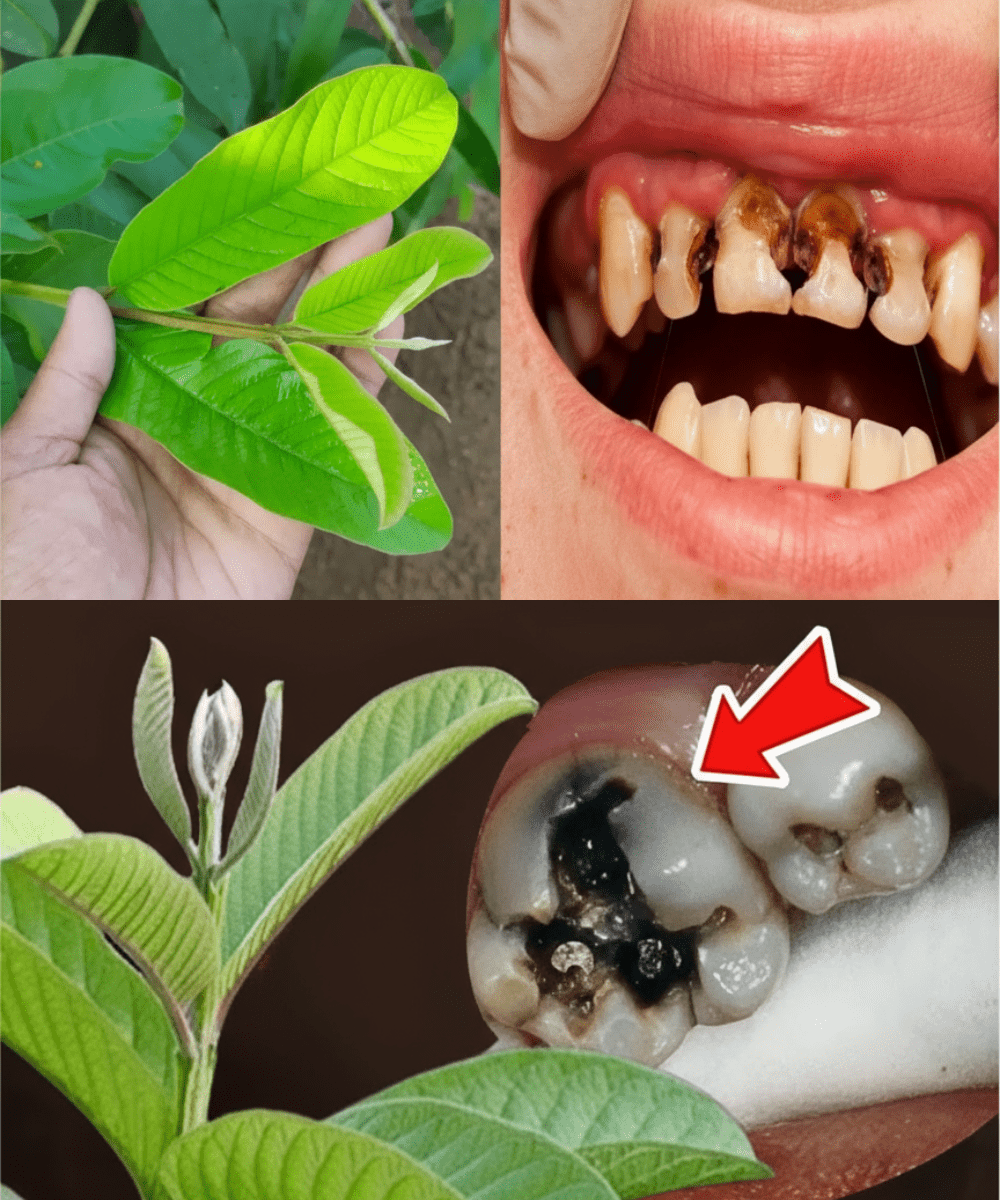
🔬 THE DENTAL PHARMACY: THE SCIENCE BEHIND GUAVA LEAF POWER
The guava leaf’s profound efficacy in oral health is due to its rich concentration of bioactive compounds, particularly polyphenols, flavonoids, and tannins. These compounds work together to address the core problems of dental decay: bacteria, inflammation, and pain.
1. 🦠 THE ANTIMICROBIAL WARRIORS (FIGHTING PLAQUE)
- Tannins and Flavonoids: These compounds function as powerful natural antibiotics. They create an environment that is highly toxic to common oral bacteria, including Streptococcus mutans (the decay-causing bacteria) and Porphyromonas gingivalis (a key bacterium in gum disease).
- Plaque Inhibition: By killing these bacteria, guava leaf extracts actively disrupt the formation of dental plaque—the sticky, colorless film that erodes tooth enamel. Regular use significantly lowers the bacterial load in the mouth.
2. 🔥 THE ANTI-INFLAMMATORY SOOTHER (PROTECTING GUMS)
- Quercetin and Catechins: These flavonoids suppress the release of inflammatory mediators (like prostaglandins) in the gum tissue. This is critical for managing gingivitis (early gum inflammation) and periodontitis (advanced gum disease).
- Tissue Strengthening (Astringent Action): The tannins act as natural astringents, helping to tighten the gum tissue around the teeth. This strengthens the gums, reduces swelling and bleeding, and creates a firmer barrier against bacteria.
3. ⚡ THE ANALGESIC RELIEVER (STOPPING TOOTHACHE)
- Direct Pain Block: The concentrated application of guava leaf compounds has a direct localized analgesic effect. They are believed to interfere with the pain signals transmitted by irritated nerves in the tooth pulp and surrounding tissues, providing fast, temporary relief from the throbbing pain of tooth decay.
🌿 THE THREE PILLARS: SIMPLE WAYS TO USE GUAVA LEAVES DAILY
Integrating guava leaves into your oral hygiene routine requires minimal effort and no expense, yet delivers maximum therapeutic results.
Pillar 1: The Traditional Chew – Direct Bacterial Kill and Freshening
This is the fastest, most traditional method, delivering the maximum concentration of active compounds directly to the mouth’s surfaces.
- Targeted Action: Ideal for reducing the bacterial population immediately after eating and for naturally combating halitosis (bad breath) caused by bacterial growth.
- The Ritual:
- Selection: Choose 2 to 3 small, young, fresh guava leaves that are clean and vibrant green.
- Cleanse: Wash the leaves meticulously under running water to remove any dust or residue.
- Chew and Swish: Place the leaves in your mouth and chew them slowly, methodically, for approximately 4 to 5 minutes. Allow the released juice (saliva mixed with the extracted compounds) to coat your entire oral cavity, focusing on areas of sensitivity or decay.
- Rinse: Spit out the chewed fibrous residue and rinse your mouth with a small amount of clean, lukewarm water.
- Frequency: Perform this ritual daily, especially after your last meal of the day, to keep the bacterial count low throughout the night.
Pillar 2: The Therapeutic Mouth Rinse – Systemic Gum and Plaque Control
For a cleaner, more generalized application, the brewed mouth rinse extracts the beneficial compounds into a solution that can reach all parts of the mouth.
- Targeted Action: Perfect for daily maintenance, fighting plaque buildup, reducing generalized gum inflammation, and serving as a natural replacement for chemical mouthwash.
- The Preparation:
- Ingredients: Use 5 to 7 fresh or dried guava leaves and 2 cups of filtered water.
- Boil and Extract: Place the water and leaves in a small, non-aluminum pot. Bring to a boil, then reduce the heat and simmer gently for 10 to 15 minutes. This simmering time is crucial for fully extracting the tannins and flavonoids.
- Cool and Strain: Remove from heat and allow the liquid to cool completely to room temperature. Strain the liquid into a clean, air-tight bottle.
- The Application:
- Use the cooled liquid as a mouthwash twice daily (morning and evening, after brushing).
- Swish vigorously for at least 30 to 60 seconds, ensuring the rinse penetrates between the teeth and along the gumline.
- Storage: Store the rinse in the refrigerator and aim to use it within 3 to 4 days for maximum potency.
Pillar 3: The Concentrated Paste – Emergency Toothache Relief
For those moments when decay flares up with severe, sharp pain, a concentrated topical paste provides swift, localized relief.
- Targeted Action: Delivers a high concentration of analgesic and anti-inflammatory compounds directly to the source of the pain.
- The Preparation:
- Crush: Take 5 to 6 fresh, young guava leaves.
- Pound: Use a mortar and pestle to crush the leaves into a very fine, smooth paste. Add a few drops of clean water or a tiny pinch of salt to adjust the consistency if needed.
- The Application:
- Take a small amount of the paste on your clean fingertip or a cotton swab.
- Apply Directly: Gently place the paste directly onto the painful tooth, around the affected gum area, and in any decay cavity (if accessible).
- Hold and Rinse: Leave the paste in place for 10 to 15 minutes. The analgesic effect should begin quickly. Rinse your mouth thoroughly with water afterward.
- Note: Use this method sparingly and specifically for pain relief.
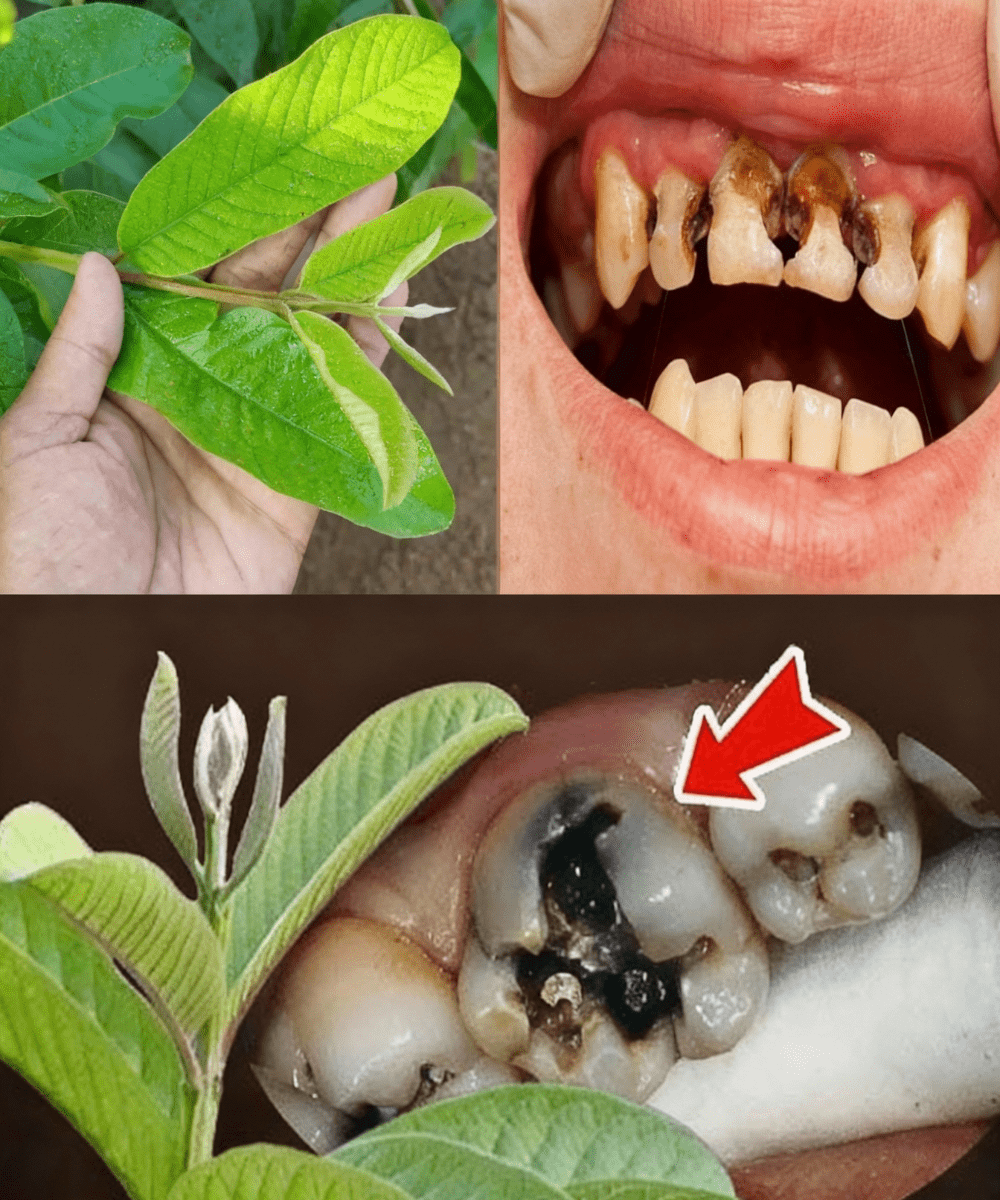
⚠️ A NOTE ON PROFESSIONAL CARE AND CAUTION
While the medicinal power of guava leaves is undeniable and supported by tradition and research, it is essential to maintain a responsible perspective on oral health:
- Natural Support, Not Replacement: Guava leaves are a powerful natural support for preventing decay and relieving symptoms. They cannot reverse existing, structural tooth decay (cavities) or replace lost tooth structure. If you have a cavity, you must see a dentist for professional filling or restorative treatment.
- The Dentist is Key: Use guava leaves as a complementary therapy alongside regular brushing, flossing, and bi-annual dental check-ups.
- Sourcing: Always use fresh, clean, and chemical-free leaves, ideally from a known organic source.
By integrating the remarkable, cost-effective power of the guava leaf into your daily oral hygiene, you are adopting an ancient, potent defense system. You are choosing to naturally combat the bacteria that cause decay, soothe your gums, and equip yourself with a fast-acting remedy for pain, ensuring your smile remains healthy and bright.
- What is the biggest barrier currently preventing you from maintaining ideal oral hygiene (e.g., flossing consistency, brushing technique)?
- Would you like simple instructions on how to grow your own small guava tree indoors or on a balcony for a constant fresh supply of leaves?

